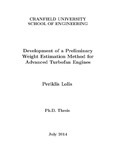JavaScript is disabled for your browser. Some features of this site may not work without it.
| dc.contributor.advisor | Sethi, Vishal | |
| dc.contributor.advisor | Pilidis, Pericles | |
| dc.contributor.author | Lolis, Periklis | |
| dc.date.accessioned | 2015-06-12T18:51:01Z | |
| dc.date.available | 2015-06-12T18:51:01Z | |
| dc.date.issued | 2014-07 | |
| dc.identifier.uri | http://dspace.lib.cranfield.ac.uk/handle/1826/9244 | |
| dc.description.abstract | The present work focuses on preliminary weight estimation methods that enable the feasibility studies of novel aero engines. The key contributions can be found in the analysis of the existing preliminary weight estimation methods, the de- velopment of a new preliminary weight estimation method and the study on the feasibility of a Geared Turbofan (GTF) engine. In more detail, the existing preliminary weight estimation methods are exam- ined in the rst part of the thesis, aiming to de ne their suitability for current turbofan engines, but also for future engine arrangements. For this purpose, they are examined not only quantitatively, to verify their accuracy, but also qualita- tively to gure out if they are able to re ect the key thermodynamic and design parameter variations on weight. Apart from NASA WATE no method achieves either the required accuracy, or simulates the weight trends. Realising the need for a more accurate, robust, exible and extensible method, a new "component based" method that performs basic component design to es- timate engine weight, is devised. Its accuracy is veri ed by comparing the whole engine weight prediction and estimated component design against the publicly available data of two major turbofan engines and the weight predictions of exist- ing weight estimation methods. ATLAS, the tool based on the above method was used to estimate weight over a range of Bypass Ratio (BPR) and Turbine Entry Temperature (TET) values for a Direct Drive Turbofan (DDTF) and a GTF two spool arrangement, reaching the following conclusions: The adjustments of Low Pressure Turbine (LPT) number of stages or geom- etry are not su cient, if high stage isentropic e ciency values are targeted at high BPR values For the examined engine model, with the given weight estimation method- ology, the weight reduction, when a gearbox is introduced at a DDTF, depends on the reduction of LPT stages, with the other components having negligible impact. However, it should be noted that a constant fan diameter was assumed for both con gurations. A fan loss model and more detailed weight estimation of frames, shafts and control and accessories is required to verify this conclusion. The comparison of a DDTF and a GTF engine is representative only if the cycles corresponding to the installed performance optima are considered.Engines with the same thermodynamic cycle could only be compared when the optima cannot be reached, due to geometry restrictions. | en_UK |
| dc.language.iso | en | en_UK |
| dc.publisher | Cranfield University | en_UK |
| dc.rights | ©Cranfield University, 2014. All rights reserved. No part of this publication my be reproduced without written permission of the copyright holder. | en_UK |
| dc.title | Development of a Preliminary Weight Estimation Method for Advanced Turbofan Engines | en_UK |
| dc.type | Thesis or dissertation | en_UK |
| dc.type.qualificationlevel | Doctoral | en_UK |
| dc.type.qualificationname | PhD | en_UK |
